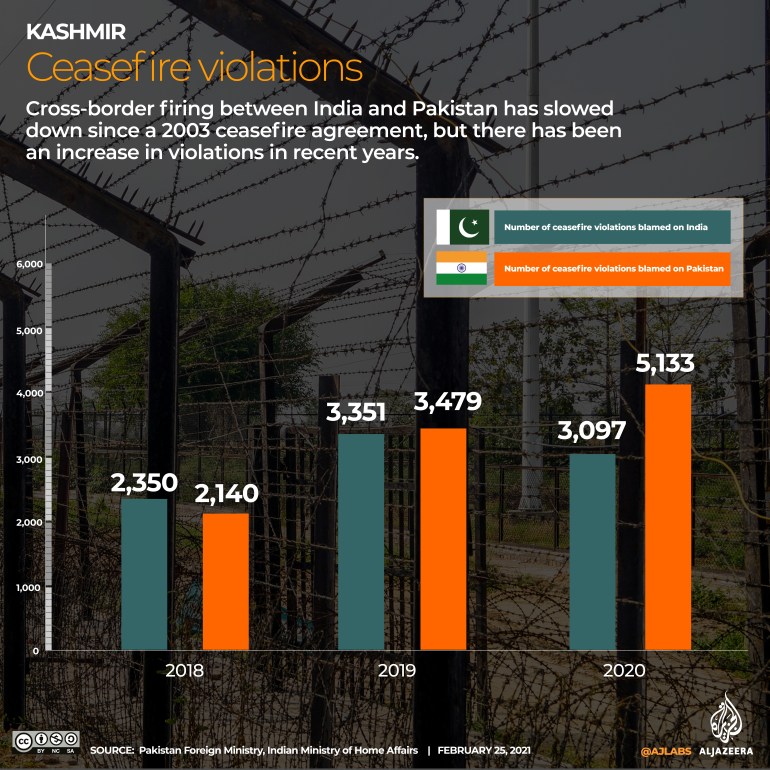India-Pakistan Ceasefire: A Delicate Path To Peace

Table of Contents
Historical Context of the India-Pakistan Ceasefire
The Legacy of Partition and Subsequent Conflicts
The 1947 partition of British India into India and Pakistan remains a defining event, leaving a legacy of mistrust and animosity that continues to shape Indo-Pak relations. This hastily executed division led to widespread violence and displacement, laying the groundwork for decades of conflict. The unresolved issues stemming from partition have fueled numerous wars and skirmishes, significantly impacting any possibility of a lasting India-Pakistan peace.
- 1947-48 War: The first war between India and Pakistan, fought over the princely state of Kashmir, established the Line of Control (LoC) as a de facto border.
- 1965 War: Another major conflict stemming from territorial disputes and border incursions, further exacerbating tensions.
- 1971 War: Resulting in the creation of Bangladesh, this war significantly altered the geopolitical landscape of the region.
- Kargil Conflict (1999): A significant military confrontation along the LoC, highlighting the fragility of peace efforts.
- Line of Control (LoC) disputes: Ongoing disagreements and violations along the LoC continue to be a major source of friction, hindering progress towards lasting peace and an India-Pakistan ceasefire.
These Indo-Pak conflicts, fueled by the partition legacy and ongoing Line of Control violations, have created a deeply entrenched cycle of hostility that needs to be broken for a sustainable ceasefire to be achieved.
Previous Ceasefire Agreements and their Success/Failures
Several ceasefire agreements have been signed between India and Pakistan throughout history, with varying degrees of success. Analyzing these past attempts offers valuable lessons for future peace initiatives. Understanding why some agreements held and others failed is crucial in shaping strategies for a lasting India-Pakistan ceasefire.
- Simla Agreement (1972): While establishing a framework for peace, it failed to fully resolve the Kashmir dispute.
- Various ceasefires along the LoC: These have often been violated, highlighting the challenges in enforcing agreements in the face of ongoing tensions and cross-border incidents.
The success or breakdown of these past agreements has often been tied to factors such as the level of political will from both sides, the involvement of external actors, and the ability to address underlying issues such as the Kashmir dispute and cross-border terrorism. Lessons learned from these past experiences are invaluable in designing effective strategies for future peace negotiations and securing a lasting India-Pakistan ceasefire.
Challenges to Achieving a Lasting India-Pakistan Ceasefire
The Role of Terrorism and Cross-Border Infiltration
Cross-border terrorism poses a significant threat to any lasting India-Pakistan ceasefire. The involvement of non-state actors and the difficulty in verifying the origin of attacks create immense obstacles to peace. A lack of trust and transparency between the two countries further complicates efforts to address the issue.
- Examples of terrorist attacks: Numerous terrorist attacks originating from across the border have fueled mistrust and hindered dialogue.
- Challenges in intelligence sharing: The lack of effective mechanisms for intelligence sharing undermines the ability to prevent future attacks.
- Anti-terrorism cooperation: A lack of genuine cooperation in combating terrorism is a major barrier to achieving lasting peace. Building trust and establishing robust mechanisms for intelligence sharing is crucial.
Addressing cross-border terrorism is not merely a security concern, it is a fundamental prerequisite for establishing a sustainable India-Pakistan ceasefire.
Kashmir Dispute as a Major Impediment
The Kashmir dispute remains the most significant obstacle to a lasting India-Pakistan ceasefire. Both countries claim the entire region, leading to decades of conflict and violence. Finding a mutually acceptable solution is critical for achieving lasting peace.
- Different perspectives on Kashmir: India and Pakistan hold fundamentally different views on the status of Kashmir, hindering any potential compromise.
- The role of international players: The involvement of international actors in mediating the dispute has had mixed results.
- Potential solutions: Exploring potential solutions such as autonomy, self-determination, or joint management requires considerable political will from both sides and a willingness to compromise.
Unless the Kashmir conflict is resolved in a way that is acceptable to both India and Pakistan, any ceasefire agreement will likely remain fragile and unsustainable.
Internal Political Dynamics in Both Countries
Internal political dynamics within both India and Pakistan significantly impact the possibility of a lasting India-Pakistan ceasefire. Nationalist sentiments, the influence of military establishments, and public opinion all play critical roles.
- Influence of nationalist sentiments: Strong nationalist sentiments in both countries can make compromises difficult, hindering peace negotiations.
- Role of military establishments: The influence of military establishments in both countries can also impact the political climate, potentially hindering peaceful resolutions.
- Public opinion: Public support for peace initiatives is crucial for the success of any ceasefire agreement.
Potential Pathways Towards a Sustainable India-Pakistan Ceasefire
Diplomacy and Dialogue
Sustained diplomatic efforts and open communication channels are essential for achieving a sustainable India-Pakistan ceasefire. This necessitates a commitment to constructive dialogue, a willingness to compromise, and the utilization of various diplomatic tools.
- Role of international mediators: Third-party mediation can play a crucial role in facilitating dialogue and building trust.
- Track-II diplomacy: People-to-people initiatives and unofficial dialogues can help build bridges and foster understanding.
- Confidence-building measures: Implementing confidence-building measures, such as increased communication and exchanges, can help reduce tensions and foster a more conducive environment for peace.
Economic Cooperation and People-to-People Contact
Increased economic cooperation and people-to-people contact can foster understanding and mutual interdependence, paving the way for a more peaceful relationship. This approach aims to create a shared stake in peace, making conflict less appealing.
- Trade agreements: Increased trade can create economic interdependence, making conflict less likely.
- Cultural exchange programs: Cultural exchanges can help break down stereotypes and foster greater understanding.
- People-to-people initiatives: Encouraging people-to-people interaction can help build bridges between the two nations.
Conclusion
Achieving a lasting India-Pakistan ceasefire is a complex and challenging undertaking, requiring sustained commitment from both sides. Overcoming historical mistrust, addressing the Kashmir dispute, and combating terrorism are crucial steps. However, the potential benefits of peace – economic growth, regional stability, and improved quality of life for millions – make the pursuit of a ceasefire a worthwhile and necessary endeavour. The path towards a lasting India-Pakistan ceasefire requires continued dialogue, focused diplomatic efforts, and a commitment from both nations to prioritize peace over conflict. Let's support initiatives that promote understanding and cooperation to achieve a sustainable India-Pakistan ceasefire and build a more peaceful future for the region. Building a lasting peace requires a concerted effort, focusing on diplomacy, conflict resolution, and building bridges between the two nations. Let’s work towards a future where the India-Pakistan ceasefire becomes a symbol of lasting peace and cooperation.

Featured Posts
-
 Crazy Rich Asians The Upcoming Television Series
May 12, 2025
Crazy Rich Asians The Upcoming Television Series
May 12, 2025 -
 Jay Kelly Kloynei Kai Santler Se Mia Nea Tainia Toy Mpompak
May 12, 2025
Jay Kelly Kloynei Kai Santler Se Mia Nea Tainia Toy Mpompak
May 12, 2025 -
 Analysis Sheehan Addresses Ipswich Towns Disappointment
May 12, 2025
Analysis Sheehan Addresses Ipswich Towns Disappointment
May 12, 2025 -
 Benny Blanco Cheating Rumors Did He Cheat On Selena Gomez With Theresa Marie
May 12, 2025
Benny Blanco Cheating Rumors Did He Cheat On Selena Gomez With Theresa Marie
May 12, 2025 -
 La Frase Es Provincia Nuestra El Piloto Argentino De F1 Que Genero Controversia
May 12, 2025
La Frase Es Provincia Nuestra El Piloto Argentino De F1 Que Genero Controversia
May 12, 2025
